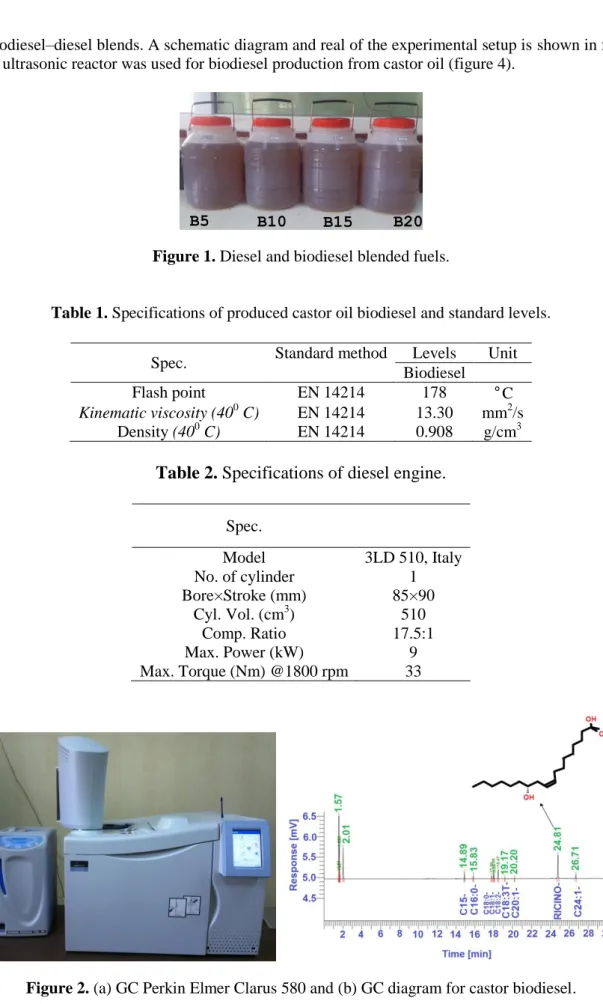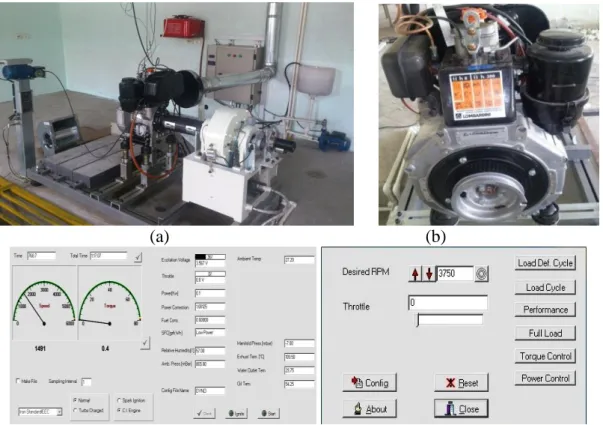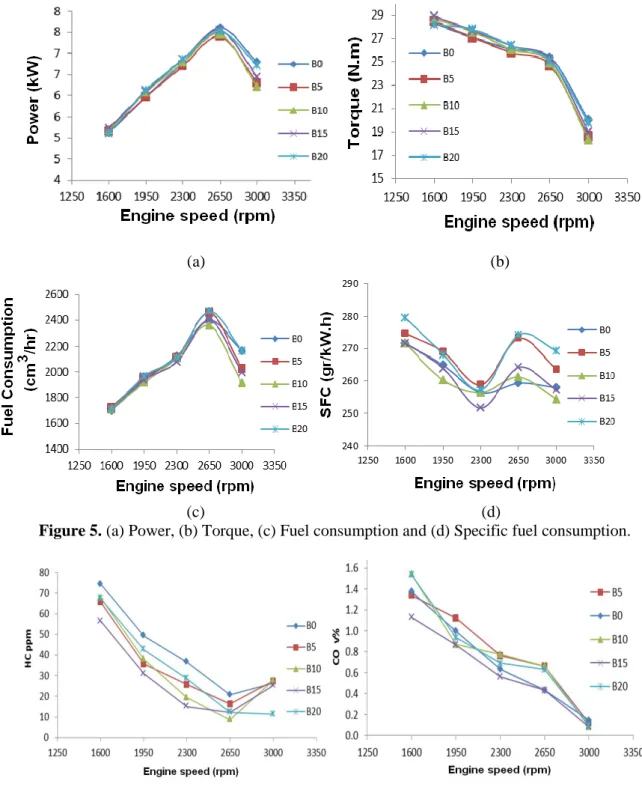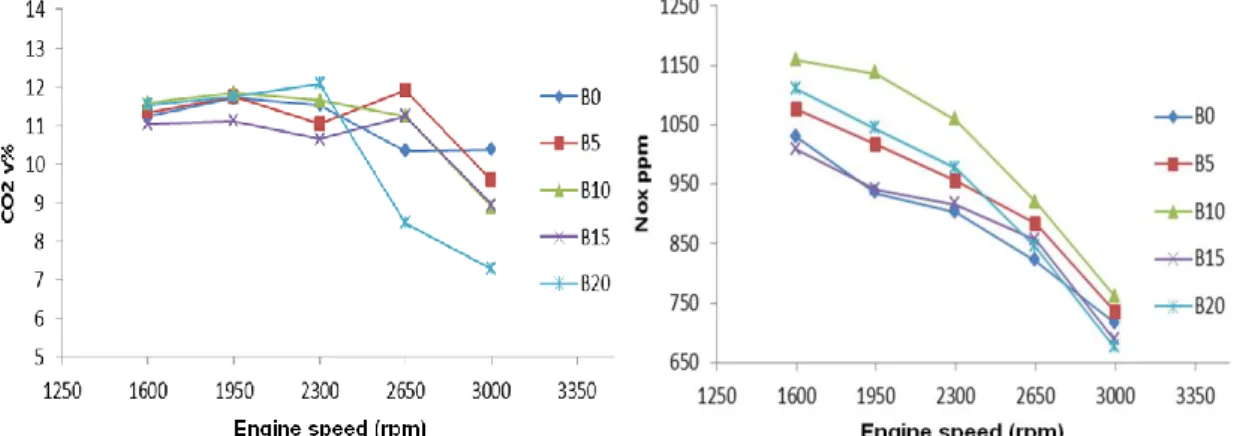This content has been downloaded from IOPscience. Please scroll down to see the full text.
Download details:
IP Address: 103.53.34.15
This content was downloaded on 21/01/2016 at 06:15
Please note that terms and conditions apply.
Performance and emission parameters of single cylinder diesel engine using castor oil
bio-diesel blended fuels
View the table of contents for this issue, or go to the journal homepage for more 2015 IOP Conf. Ser.: Mater. Sci. Eng. 100 012012
(http://iopscience.iop.org/1757-899X/100/1/012012)
Performance and emission parameters of single cylinder diesel
engine using castor oil bio-diesel blended fuels
A Rahimi1, B Ghobadian1, G Najafi1, F Jaliliantabar1 and R Mamat2 1
Faculty of Biosystem Engineering, Tarbiat Modares University, Tehran, Iran 2
Faculty of Mechanical Engineering, Universiti Malaysia Pahang,Malaysia
E-mail: ghobadib@modares.ac.ir
Abstract. The purpose of this study is to investigate the performance and emission parameters of a CI single cylinder diesel engine operating on biodiesel-diesel blends (B0, B5, B10, B15 and E20: 20% biodiesel and 80% diesel by volume). A reactor was designed, fabricated and evaluated for biodiesel production. The results showed that increasing the biodiesel content in the blend fuel will increase the performance parameters and decrease the emission parameters. Maximum power was detected for B0 at 2650 rpm and maximum torque was belonged to B20 at 1600 rpm. The experimental results revealed that using biodiesel–diesel blended fuels increased the power and torque output of the engine. For biodiesel blends it was found that the specific fuel consumption (sfc) was decreased. B10 had the minimum amount for sfc. The concentration of CO2 and HC emissions in the exhaust pipe were measured and found to be
decreased when biodiesel blends were introduced. This was due to the high oxygen percentage in the biodiesel compared to the net diesel fuel. In contrast, the concentration of CO and NOx was found to be increased when biodiesel is introduced.
1.Introduction
The CI engines are widely utilized due to its reliable operation and economy. As the petroleum reserves are depleting at a faster rate, an urgent need for a renewable alternative fuel arise [1, 2]. Also the threat of global warming and the stringent government regulation made the engine manufacturers and the consumers to follow the emission norms to save the environment from pollution [3]. Among the many alternative fuels, biodiesel is considered as a most desirable fuel extender and fuel additive due to its high oxygen content and renewable in nature [4]. Alternative fuels for diesel engines are becoming increasingly important due to diminishing petroleum reserves and the environmental consequences of exhaust gases from petroleum fuelled engines [5, 6].
A number of studies have shown that triglycerides hold promise as alternative diesel engine fuels. So, many countries are interested in that, for example, evaluation of the production of biodiesel in Europe since 1992 shows an increasing trend [7]. Waste vegetable oil methyl ester is a biodiesel. Biodiesel is defined as the mono alkyl esters of long chain fatty acids derived from renewable lipid sources [8]. Biodiesel, as defined, is widely recognized in the alternative fuel industry. Biodiesel is typically produced through the reaction of a vegetable oil or animal fat with methanol in the presence of a catalyst to yield glycerin and methyl esters [9]. The blend of 75:25 ester/diesel (B25) gave the best performance [10].
Among the attractive features of biodiesel fuel are: (i) it is plant, not petroleum-derived, and as such its combustion does not increase current net atmospheric levels of CO2 a ‘‘greenhouse’’ gas; (ii) 3rd International Conference of Mechanical Engineering Research (ICMER 2015) IOP Publishing IOP Conf. Series: Materials Science and Engineering100(2015) 012012 doi:10.1088/1757-899X/100/1/012012
it can be domestically produced, offering the possibility of reducing petroleum imports; (iii) it is biodegradable; and (iv) relative to conventional diesel fuel, its combustion products have reduced levels of particulates, carbon monoxide, and, under some conditions, nitrogen oxides.
It is well established that biodiesel affords a substantial reduction in SOx emissions and considerable reductions in CO, hydrocarbons, soot, and particulate matter (PM) [11]. There is a slight increase in NOx emissions, which can be positively influenced by delaying the injection timing in engines [12].
Castor (Ricinus communis L.) is one of the most promising non-edible oil crops, due to its high annual seed production and yield, and since it can be grown on marginal land and in semi-arid climate. Currently, edible oils account to more than 95% of the world biodiesel production. This is due to the fact that they are easily available from large scale agricultural production activities; however, this is not a desirable situation due to the potential impacts on food supply leading to the so called “food versus fuel dispute”.
In addition to the social aspects, it is known that the cost of the raw-materials can account for 70– 95% of total biodiesel production cost; therefore, alternative low cost raw materials are also essential to overcome economic constraints to its production. Amongst the most studied crops are: jatropha, karanja, castor rice bran, linseed, coriander, tobacco seed, cotton, rubber and wild mustard.
The comparison of plantation costs and oil yields of the mentioned crops, place castor clearly on the top of the most interesting non-edible crops. The castor oil seeds usually contain 40–55% of oil, a very high potential as compared to other most commonly used oil crops (soybean: 15–20% (w/w), sunflower: 25–35% (w/w), rapeseed: 38–46% (w/w), and palm: 30–60% (w/w)). In addition, the cost of plantation can be 50% of the cost of planting rapeseed and 25% of the cost of planting jatropha [13]. 2. Experimental set up
2.1. Design of experiment
The performance and emission parameters from the engine running on biodiesel (derived from castor oil) and blended with diesel fuel (B5, B10, B15 and B20) were evaluated and compared with diesel fuel (B0) (figure 1). The properties of biodiesel fuel investigated and it has been proved that all specifications are in the standard range based on the ASTM standard (table 1). Gas Chromatography (GC) machine was utilized to biodiesel product analysis (figure 2). Above 20% biodiesel, engine could not run smoothly, therefore, only experimental results obtained up to this percentage of biodiesel will be presented. The fuel blends were prepared just before starting the experiment to ensure that the fuel mixture was homogenous.
A series of experiments were carried out using diesel, and the various biodiesel blends. All the blends were tested under varying engine speed conditions (1600, 1950, 2300, 2650 and 3000 rpm). The engine was started using diesel fuel and it was operated until it reached the steady state condition. The engine speed, fuel consumption, and load were measured. After the engine reached the stabilized working condition, performance and emission parameters were measured. All experiments have been carried out at full throttle setting. To adjust ignition timing, electronic ignition system was used.
Before obtaining data from the engine operated with a new blended fuel, the engine was operated using the new fuel for sufficient time to clean out the remaining fuel from the previous blend. In this paper, the quantity BX represents a blend consisting of X% biodiesel by volume, e.g., B5 indicates a blend consisting of 5% biodiesel in 95%diesel. Five test fuels were used in this study: 0% biodiesel (B0); 5% biodiesel (B5); 10% biodiesel (B10); 15% biodiesel (B15); and 20% biodiesel (B20). The experiments were performed on one cylinder, four-stroke, and compression-ignition (CI) Diesel engine (specification of engine has been illustrated at table 2).
A SCHENCK eddy–current dynamometer was used in the experiments. Fuel consumption rate was measured by using laminar type flow meter, Pierburg model. Air consumption was measured using an air flow meter. Five separate fuel tanks were fitted to the gasoline engine and this contained diesel and 3rd International Conference of Mechanical Engineering Research (ICMER 2015) IOP Publishing IOP Conf. Series: Materials Science and Engineering100(2015) 012012 doi:10.1088/1757-899X/100/1/012012
the biodiesel–diesel blends. A schematic diagram and real of the experimental setup is shown in figure 3. An ultrasonic reactor was used for biodiesel production from castor oil (figure 4).
Figure 1. Diesel and biodiesel blended fuels.
Table 1. Specifications of produced castor oil biodiesel and standard levels.
Spec. Standard method Levels Unit Biodiesel
Flash point EN 14214 178 °C Kinematic viscosity (400 C) EN 14214 13.30 mm2/s
Density (400 C) EN 14214 0.908 g/cm3
Table 2.
Specifications of diesel engine.
Spec. Model 3LD 510, Italy No. of cylinder 1 Bore×Stroke (mm) 85×90 Cyl. Vol. (cm3) 510 Comp. Ratio 17.5:1 Max. Power (kW) 9 Max. Torque (Nm) @1800 rpm 33
Figure 2. (a) GC Perkin Elmer Clarus 580 and (b) GC diagram for castor biodiesel.
B5 B10 B15 B20
3rd International Conference of Mechanical Engineering Research (ICMER 2015) IOP Publishing IOP Conf. Series: Materials Science and Engineering100(2015) 012012 doi:10.1088/1757-899X/100/1/012012
(a) (b)
(c)
Figure 3. (a) Engine test set-up, (b) Single cylinder diesel engine and (c) controlling setup
(a)
(b) (c) (d) (e)
Figure 4. (a) Castor oil, (b) Ultrasonic machine for transestrification reaction, (c) biodiesel+ glycerol, (d) washing process and (e) biodiesel.
3. Results and discussion
Figure 5 shows the effect of various fuels on engine performance parameters. When the biodiesel content in the blended fuel is increased, the engine power and torque slightly increased for all engine speeds. The gain of the phenomena can be attributed to the increase of the indicated mean effective pressure for higher biodiesel content blends. With the increase in biodiesel percentage, the density of the mixture and the engine volumetric efficiency increases and this causes the increase of power. 3rd International Conference of Mechanical Engineering Research (ICMER 2015) IOP Publishing IOP Conf. Series: Materials Science and Engineering100(2015) 012012 doi:10.1088/1757-899X/100/1/012012
The trend of performance curves (power and torque) are very common like those mentioned in valid concerned existing literature. Range of speed was selected between 1600 rpm and 3000 rpm. Engine test results with net diesel fuel showed that maximum torque was 27.2 Nm which occurred at 1600 rpm. The maximum power was 8 kW at 2650 rpm.
Power and torque for fuel blends at full load are shown in Figure 5. Considering power and torque performance with fuel blends, one can say that the trend of these parameters vs. speed is perfectly similar to net diesel fuel. Figure 5 (a) shows engine speed and engine power relationship at full load condition using net diesel fuel and fuel blends. The net diesel fuel was used as a base for comparison. The fuel blend behavior was similar to that of net diesel fuel in developing power. Figure 5 (c) and (d) shows fuel consumption and specific fuel consumption with various fuels blend percentage. The curves show that brake specific fuel consumption of fuel blends trends is very similar to net diesel fuel. Specific fuel consumption of fuel blends is higher than net diesel fuel. In other words, increasing fuel blend percentage, a mild increase in brake specific fuel consumption is observed. The gain of the engine power can be attributed to the increase of the indicated mean effective pressure for higher biodiesel content blends [14] .
The heat of evaporation of biodiesel is higher than that diesel, this provides fuel–air charge cooling and increases the density of the charge, and thus higher power and torque output is obtained [15]. With the increase in biodiesel percentage, the density of the mixture and the engine volumetric efficiency increases and this causes the increase of power. Added biodiesel produces lean mixtures that increase the relative air–fuel ratio to a higher value and makes the burning more efficient. The improved anti-detonation behavior) allowed a more advanced timing that results in higher combustion pressure and thus higher torque [16] .
For biodiesel blends it was found that the specific fuel consumption (sfc) was decreased. B10 had the minimum amount for sfc. The sfc decreases as the biodiesel percentage increases. This is due to the increase in brake thermal efficiency due to increase of indicated work [17]. The concentration of CO2 and HC emissions in the exhaust pipe were measured and found to be decreased when biodiesel blends were introduced. This was due to the high oxygen percentage in the biodiesel compared to the net diesel fuel. As a result of the lean burning associated with increasing biodiesel percentages, the CO2 emission decreased because of the improved combustion [11].
In contrast, the concentration of CO and NOx was found to be increased when biodiesel is introduced. The CO concentration increases which means the combustion is tuned to be completed [18]. The reduction in CO concentration using blended fuels is due to the fact that biodiesel has higher carbon than diesel. Another significant reason of this increase is that the oxygen content in the blended fuels increases. The oxygen-to-fuel ratio in the fuel-rich regions. Relative air–fuel ratio approaches 1 as the biodiesel content of the blended fuel increases, and consequently combustion be comes complete.
The NOx concentration is higher when biodiesel percentage increases. When the combustion process is closer to stoichiometric, flame temperature increases, therefore, the NOx emission is increased, particularly by the increase of thermal NO. Due to higher performance and lower emissions, it has been recommended to use 10 Volume% biodiesel in diesel fuel in diesel engines [18, 19].
Biodiesel contains oxygen in its structure. When biodiesel is added to diesel fuel, the oxygen content of fuel blend is increased and thus less oxygen is needed for combustion. However, oxygen content of fuel is the main reason for more complete combustion and hence HC emission reduction. Figure 6 show the relationship between the fuel blends and CO and HC concentrations respectively. The concentration of CO2 and HC emissions in the exhaust pipe were measured and found to be decreased when biodiesel blends were introduced. This was due to the high oxygen percentage in the biodiesel compared to the net diesel fuel. In contrast, the concentration of CO and NOx was found to be increased when biodiesel is introduced.
3rd International Conference of Mechanical Engineering Research (ICMER 2015) IOP Publishing IOP Conf. Series: Materials Science and Engineering100(2015) 012012 doi:10.1088/1757-899X/100/1/012012
(a) (b)
(c) (d)
Figure 5. (a) Power, (b) Torque, (c) Fuel consumption and (d) Specific fuel consumption.
(a) (b)
3rd International Conference of Mechanical Engineering Research (ICMER 2015) IOP Publishing IOP Conf. Series: Materials Science and Engineering100(2015) 012012 doi:10.1088/1757-899X/100/1/012012
(c) (d)
Figure 6. (a) HC, (b) CO, (c) CO2 and (d) NOx emissions.
4. Conclusions
The results revealed that increasing the biodiesel content in the blend fuel will increase the performance parameters and decrease the emission parameters. Maximum power was detected for B0 at 2650 rpm and maximum torque was belonged to B20 at 1600 rpm. The experimental results revealed that using biodiesel–diesel blended fuels increased the power and torque output of the engine. The gain of the engine power can be attributed to the increase of the indicated mean effective pressure for higher biodiesel content blends. The heat of evaporation of biodiesel is higher than that diesel, this provides fuel–air charge cooling and increases the density of the charge, and thus higher power output is obtained.
For biodiesel blends it was found that the specific fuel consumption (sfc) was decreased. B10 had the minimum amount for sfc. The sfc decreases as the biodiesel percentage increases. This is due to the increase in brake thermal efficiency due to increase of indicated work. The concentration of CO2 and HC emissions in the exhaust pipe were measured and found to be decreased when biodiesel blends were introduced. This was due to the high oxygen percentage in the biodiesel compared to the net diesel fuel. As a result of the lean burning associated with increasing biodiesel percentages, the CO2 emission decreased because of the improved combustion.
In contrast, the concentration of CO and NOx was found to be increased when biodiesel is introduced. The CO concentration increases which means the combustion is tuned to be completed. The NOx concentration is higher when biodiesel percentage increases. When the combustion process is closer to stoichiometric, flame temperature increases, therefore, the NOx emission is increased. Due to higher performance and lower emissions, it has been recommended to use 10 Volume% biodiesel in diesel fuel in diesel engines.
Acknowledgements
The authors wish to thank the Iranian Fuel Conservation Organization (IFCO) of NIOC for the research grant provided (project number IFCO-1393) to complete this project and Mega Motor Company for providing of laboratory facilities.
References
[1] Demirbas A 2007 Progress in Energy and Combustion Science 33 1-18 [2] Gumus M 2010 Fuel 89 2802-14
[3] Aydin H, Bayindir H 2010 Renewable Energy 35 588-92 [4] Prakash R, Singh R K, Murugan S 2013 Energy 55 610-8
3rd International Conference of Mechanical Engineering Research (ICMER 2015) IOP Publishing IOP Conf. Series: Materials Science and Engineering100(2015) 012012 doi:10.1088/1757-899X/100/1/012012
[6] Sánchez N, Sánchez R, Encinar J M, González J F, Martínez G 2015 Fuel 147 95-9
[7] Shahir V K, Jawahar C P, Suresh P R 2015 Renewable and Sustainable Energy Reviews 45 686-97 [8] Tsai S-Y, Tseng W-S, Wu C-T, Lin C-P 2014 Procedia Engineering 84 940-7
[9] Meller E, Green U, Aizenshtat Z, Sasson Y 2014 Fuel 133 89-95
[10] Mejía J D, Salgado N, Orrego C E 2013 Industrial Crops and Products 43 791-7
[11] Panwar N L, Shrirame H Y, Rathore N S, Jindal S, Kurchania A K 2010 Applied Thermal Engineering 30 245-9
[12] Wander P R, Altafini C R, Colombo A L, Perera S C 2011 Energy 36 3917-23
[13] Dias J M, Araújo J M, Costa J F, Alvim-Ferraz M C M, Almeida M F 2013 Energy 53 58-66 [14] Lin Y-S, Lin H-P 2011 Renewable Energy 36 3507-16
[15] Thomas T P, Birney D M, Auld D L 2012 Industrial Crops and Products 36 267-70 [16] Valente O S, Pasa V M D, Belchior C R P, Sodré J R 2011 Fuel 90 1700-2
[17] López J M, Cota T d N J G, Monterrosas E E G, Martínez R N, de la Cruz González V M, Flores J L A, et al. 2011 Chemical Engineering Journal 178 391-7
[18] Yahyaee R, Ghobadian B, Najafi G 2013 Renewable and Sustainable Energy Reviews 17 312-9 [19] Atabani A E, Silitonga A S, Ong H C, Mahlia T M I, Masjuki H H, Badruddin I A, et al. 2013
Renewable and Sustainable Energy Reviews 18 211-45
3rd International Conference of Mechanical Engineering Research (ICMER 2015) IOP Publishing IOP Conf. Series: Materials Science and Engineering100(2015) 012012 doi:10.1088/1757-899X/100/1/012012



